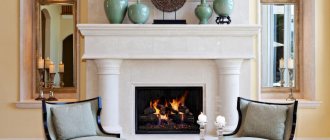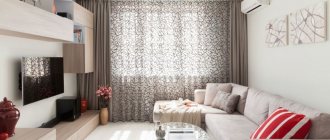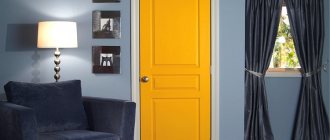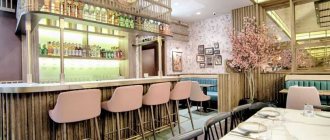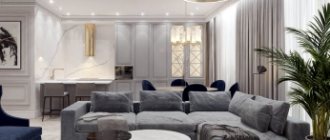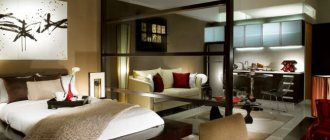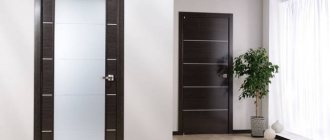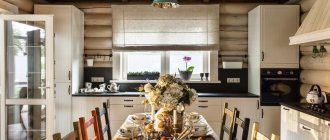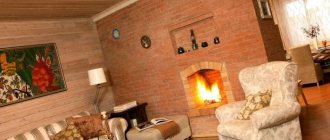We tell you important and relevant principles of home improvement, thanks to which even a non-professional can create a stylish and functional interior. Ways to create unusual color accents, the second life of old furniture, the selection of an individual lighting scheme for each room, current trends in color schemes, the differences between style and stylization, individualization of the interior and new ways of decorating it - all this is discussed in the article.
You will learn:
- is it worth trying to recreate a palace interior in a modern home;
- how to combine different styles in one room;
- ways of harmoniously arranging furniture;
- how to light the interior to make it truly cozy;
- fashionable and pleasant colors that will breathe life into the decor of your home or apartment;
- how to replace mismatched decor to make the interior look cohesive
Block painting is a way of zoning and adding color
Expand the range of color accents in your interior
Only the lazy did not say that textile elements (pillows, curtains, tablecloths, bedspreads) can become color accents of the interior. To really make the interior sparkle with new colors, use other methods. For example, color block on the walls is also a means of zoning space. Thus, a vertical strip behind the head of the bed will effectively highlight the sleeping area.
Indoor flowers become refreshing color accents that never get boring. It is not at all necessary to habitually display them in a row on the windowsills. Group all the plants together, perhaps by placing them on a tall rack or tiered wall shelf.
A home library can also add color to the interior. Arrange your favorite books according to the shades of their spines, forming a rainbow or gradient. If necessary, make covers from colored paper: after all, most books cannot boast of brightness.
Painted wall behind the headboard as a way to zone the sleeping area
Add a piece of yourself to the interior
You should remember that you are arranging the interior for yourself. Be sure to add something related to you to give the room warmth. Design elements such as paintings, decorative pillows, armchairs, and unusual curtains on the windows can tell a lot about the owner’s taste.
Adviсe:
- Be sure to add memorable photos or paintings to the interior. You can organize other elements around them, such as lighting or furniture.
- Do not place paintings very high. You should hang them just above the middle of the wall.
Light can be useful: a little about the correction of living spaces
Use lighting fixtures to the maximum: not only for their intended purpose, but also as a tool for correcting the shortcomings of the room. Thus, wall lamps directed upwards will help increase the height of the ceilings, and reduce them - downwards. You can expand a narrow space by placing lamps along a long wall or highlighting the lower corners of the room. To narrow a room, use a technique such as placing lamps along the midline of the ceiling. And if you need to visually increase the volume of the living space as a whole, choose the brightest main lighting possible.
Lighting will set accents
In the interior, every detail is important. Therefore, you need to choose the right light. With the help of correctly selected lighting, it is possible to visually raise ceilings, give the space more volume, and also hide minor design flaws.
Recommendations:
- Make the most of daylight.
- Don't forget about wall lights, candles and floor lamps. They are the ones who give coziness to the room.
- If the room is large, then 4 to 8 light sources are needed. If the room is small, then 2-4 is enough.
- Pay attention to the mirrors. If they are placed opposite the window, the room will look brighter and will also visually expand.
Related article: Colored interior for different rooms
Always give old furniture a second chance
The first reason that people in different parts of the world use when refusing new purchases is the desire for conscious consumption. Even if this motivation seems unconvincing to you, furniture with history deserves a second chance thanks to its high quality and often exclusive design.
Updating furniture yourself is not difficult; Decorating techniques such as decoupage, patination, aging, the use of textured pastes, stencils will help... Patience and a little imagination - and you will become the owner of a unique piece of furniture. Sometimes it is not necessary to update furniture, for example, if you plan to create an eclectic interior where objects from different eras coexist.
Only a multi-level lighting scenario can be complete
Soffits, chandeliers, spots under the ceiling, that is, the first or main level of lighting, are not enough. Its task is to illuminate all corners of the room even in the dark with diffused light. On the second level there are wall sconces and floor lamps designed to illuminate a certain part of the room. The third level (bedside lamp, table floor lamp) is called a point level and has an even narrower purpose: to illuminate a functional area, for example, a work desk, kitchen countertop, or sleeping area. There is a fourth, additional level: interior lighting of cabinets or shelving, LED lighting of the floor or ceiling, and individual decorative items on the wall.
Multiple levels of lighting in the living room
A multi-level lighting scenario will not only greatly increase the functionality of the interior, but also visually enlarge the space and help create a cozy atmosphere thanks to the creation of soft shadows. Remember hotels, where bedside tables, table lamps, and bathroom mirror lighting are required, and adopt these techniques for “domesticating” space.
Design for Beginners: 9 Mistakes and How to Avoid Them
Everyone’s approach to creating an interior is individual, and if you are not a professional designer, mistakes are inevitable. What can I say - from time to time even the pros step on the same rake. To save you from this rake, we have collected 9 common mistakes.
Don’t try to replicate the interior from the magazine exactly
When decorating a space, do not forget that this is an interior for a comfortable life, and not a photo shoot for an interior publication. Don't turn your home into a design museum. The shine of polished parquet and the ideal distances between vases - all this makes the interior soulless and toy-like. Breathe life into it and make it yours rather than trying to recreate a magazine cover.
Don't combine small items in a small space
Many people are intimidated by small spaces and try to fit the maximum into it by choosing small interior items. We advise you not to make a dollhouse, but to buy medium-sized items so as not to reduce their functionality and usefulness. 5 medium elements are better than 10 small ones.
Don't overload the interior with details
It's easy to go overboard when playing with decor, especially if you're working with a multifunctional space. When buying the 105th candle for the living room, think about whether it is unnecessary? Know how to stop in time to avoid overloading the space. Everyone needs air, even things.
Do not try to maintain the unity of one style
Don't get attached to one style in the interior. Your home will be able to combine both modern and classic elements. It is important to try and develop your own decorating style, regardless of traditional gradations.
Don't overuse symmetry
A common mistake when decorating walls: the images must be on the same line and located symmetrically. Away with boring and regular forms - come up with a new picture of paintings. But try not to hang them from the ceiling, unless it is a full-wall canvas.
Don't forget the importance of lighting
Size matters. This also applies to lighting. When choosing fixtures and lamps, take into account the size of the room and the height of the ceiling. For a large space - a large chandelier.
Don't be afraid to use minimalism
There is a misconception that minimalist modern design is boring, cold and not at all suitable for life. If you're worried about turning your home into a spaceship, simply add neutral accessories and personal items to domesticate the interior. And remember about natural materials - they will refresh a strict and restrained image.
Don't leave windows unattended
Our layouts often do not include panoramic windows, and in some houses they are too small to say “at all.” To visually correct this, raise the curtain rod to ceiling height and lower light wavy curtains. This will make small windows look larger and more solid.
Don't create an interior around one item
A common mistake not only by designers, but also by amateurs is to put one element of the interior at the forefront. It's simple: set the reference point of the future image and surround it with compatible details. But the end result may be boring and one-sided. It is much better to make several accents and place various objects around them. And instead of the solar system, you will get a real constellation of comfort and beauty.
The road to a beautiful and comfortable interior is thorny and difficult. Remember the 9 main “DON’Ts” and we’re sure you’ll be able to create a cozy atmosphere in your home. And if not, legko.com is always in touch!
Each room has individual lighting parameters
The brightest room should be the living room: aim for 20 watts of light output per square meter of area. Here it is better to use a three-level lighting scenario. The bedroom has sufficiently low lighting (10-12 W per m²), for example, the main and spot levels. Moderately illuminated (15-18 W per m²) rooms include a children's room, a bathroom, a kitchen, and a study.
The lighting scenario is selected based on the specifics of the room and the lifestyle of the owners. So, it is not necessary to hang a chandelier in the kitchen, but you should take care of lighting the countertops, shelves, stove, and dining table. In the children's room, lamps above the play area, night lights with soft light, and in the bathroom - light bulbs around the mirror are useful.
Dim light in the bedroom
Contemporary furniture sets the character of the interior
Several restored pieces of furniture can fit into almost any interior. But the basis of the furnishings will still be modern things. Nowadays furniture with round shapes is considered popular: poufs, consoles, bay window sofas, soft armchairs. Between strict geometry and smooth lines, the choice is made in favor of the latter. Furniture, following fashion trends, increases in size, which may seem like a problem for owners of small apartments. The solution for them will be furniture with elegant legs in brass, chrome or copper color, which does not visually overload the room.
Upholstered furniture with a carriage screed is receding into the past, and it is being replaced by models with a flat surface. Sliding wardrobes with patterns on the mirror have also moved irrevocably away from current trends. They are being replaced by storage systems with hinged doors made of glass or MDF, laconically decorated with metal inserts. Also, the concept of “furniture set” disappears. To keep up with the times, collect items from different furniture collections in one room.
Furniture with metal legs is still relevant
Space, composition and its laws
In any university you will immediately be bombarded with words from the theoretical part of design. The environment is what surrounds a person and what is created by the designer from a variety of objects. Space is a form of representation of material things. Space characterizes a person, carries an atmosphere, and individualizes his life. Composition is the expressive interaction of various objects, colors, materials. There are laws of composition that, as the university will tell you, are absolutely impossible to violate, but modern interiors prove time after time that now not only “harmonious” interiors are in fashion, but also “mind-activating”, “inspiring”, “breaking stereotypes of thinking” " and so on.
However, having learned the laws of composition, it will be easier for you to make specific small decisions at the first stage of design. With them, perhaps, you can start a “lazy” study of the basics of interior design.
Light “heating” or “cooling” - this is important
The influence of spectrum temperature on a person’s emotional state and biorhythms should not be underestimated. For the work area, cool light is suitable, helping to concentrate attention, and in the bedroom and living room - warm light, promoting relaxation. The temperature of the light is also significant when choosing the type of lighting. For the main one, that is, the ceiling, a cold spectrum is suitable, for the rest - a warm one. You shouldn’t get carried away with cold light in your living space: it is more suitable for public places. If you want to create the most cozy atmosphere, then replace cold lamps with neutral white ones.
It is also worth considering the color scheme of the interior. To avoid distortion, cold or warm tones are illuminated with lamps of the same spectrum or neutral ones.
How to find out the temperature of the light? All modern lamps have markings on the light they emit, which is worth studying before purchasing. Another way is to hold a lit light bulb to a piece of white paper. A yellowish or bluish glow will indicate the temperature: warm and cold, respectively.
Golden rules in interior design
Creating an interior design is a creative process, which is only limited by imagination and possibilities.
Design rules, which aren't really rules but rather guidelines, help you figure out what you want from a room. Stylish and comfortable interior design does not come out of nowhere, so we will look at 5 main points for creating the ideal apartment interior.
Assignment of rooms
The first thing that is important to decide is the purpose of each room. If you don't know what the room will be used for, then no amount of renovation or furniture can make the design good.
To do this, it is necessary to take into account interests and hobbies, daily routine, and individual preferences. It is also important to decide what rooms you will need for what purpose: for example, using the zoning technique, you can combine the kitchen and dining room.
After this, you can move on to planning the room.
Atmosphere of the room
Psychologists have proven that the mood and state of a person depend on the mood created in the room. Before you arrange your home, decide how you would feel in it: active or peaceful. It is important to realize that this will impact guests as well.
For this:
- Decide on a color scheme. Read our article 10 fashion trends in interior design in 2021 and choose the shade that will reflect your state.
- Decide which material is suitable: natural or artificial.
Lighting
Mood and well-being are equally influenced by lighting, which can radically transform the atmosphere of a room. Correctly placed accents of light help influence the emotional state.
To create a pleasant atmosphere:
- Do not clutter the windows - natural daylight should be the main one.
- Use mirrors or mirrored surfaces to help make the room appear larger.
To highlight a specific area in the room (for example, a sitting area in the bedroom or a work surface in the kitchen), use local lighting: lamps and floor lamps.
We combine the incongruous
Don't be afraid to mix styles. Established design rules are being replaced by polystylistics, when vintage and ultra-modern things can harmoniously coexist in the same room interior. This also applies to materials: a combination of stone and glass and so on. So, for example, choosing a neutral color scheme in the interior design of the living room.
Visual anchors that define the interior
What are visual anchors? Think about it, if you were a guest in your apartment, what would you remember? It is the accent details: objects or color schemes that catch the eye and make the interior design memorable and original.
Just don’t overdo it: there shouldn’t be more than 3-5 such visual anchors in the interior design room of one room. And there must be connecting points between all the details that create a certain pattern. This way you can combine colors or textures.
These are the basic rules of interior design that will help create a favorable atmosphere in a house or apartment. It is not necessary to strictly follow all the recommendations, the main thing is to surround yourself with what you love, do not clutter the room, know how to part with old and unnecessary things, be guided by your own feelings and emotions. Make the interior design of your room inspire and delight!
Natural light is a priority
When arranging the interior, artificial light is given a lot of attention, but it is still secondary to natural light. Changing the illumination outside the window will not work, but not preventing the penetration of sunlight into the room and skillfully using optical illusions for the sake of a bright present is quite possible. Natural light's best friends are large mirrors, furniture with glass shelves, table tops or made of transparent plastic, balcony doors with thin frames or no frames, all types of reflective surfaces, including metal ones. It is better not to place massive cabinets on the sides of the windows and not to install various delimiting structures.
Light curtains, reflective surfaces, low furniture - help in preserving light
What problems do designers solve?
Before self-training to become an interior designer from scratch, you need to understand what the profession is. Not everyone knows why people hire designers. In addition, there are a lot of nuances in this specialty.
An interior designer is a specialist who specializes in arranging space. It solves a whole range of different problems.
The designer develops the concept of the premises and supervises the implementation of repair work. Both the planning of the future interior and the implementation of conceived ideas fall on his shoulders. Must have communication skills and understand a range of computer programs.
The designer's responsibilities include the following:
- conducting negotiations with the customer;
- development of interior projects for office and residential premises;
- work with documentation according to SNIP and GOST standards;
- budgeting;
- visualization of the result using computer programs;
- author's supervision of the project.
People who want to become a designer are primarily interested in what they need to be able to do in this profession. Designers are multitasking specialists. Their activities vary depending on the stage of work.
A professional’s skills include: the ability to see the finished result and correctly present it to the customer. After all, everyone will want to see the future interior from different angles in the smallest detail.
Useful links: What does a landscape designer do, Sketching lessons, Designer's portfolio examples, Working as an art director.
Qualities of a successful designer
The main feature of the profession of an interior designer is that he has to combine dynamic and monotonous work. In some cases, its activities may be associated with stress. A good specialist must have a whole set of qualities.
Important qualities of an interior designer include:
- Foresight that will allow you to see the final result of the project. Thanks to it, it will be easier for a specialist to convey his thoughts and suggestions to the customer.
- The presence of artistic taste and imaginative thinking. This helps create a picture in your head.
- A creative mind will provide an inexhaustible supply of diverse ideas.
- Self-discipline will allow you to complete the work on time, even in the absence of control from the customer.
- Sociability – the ability to win over others. It will be useful when establishing contacts with customers and colleagues.
- Patience and loyalty to criticism are qualities necessary when encountering difficulties in work. The designer may be faced with a situation where the project will have to be completely redone. In this case, you need to find the strength to start it over again, taking into account the mistakes made.
What you need to know: basic skills
When training to become a designer, it is important to know what is needed for the job and how to correctly apply the skills in action.
What you need to know to become a designer is clearly displayed in the table.
| Skill | Description |
| Originality | Develop the ability to form a unique view of things, successfully generate ideas and combine them with each other. |
| Sense of taste | The ability to apply certain techniques in practice, avoiding bad taste. |
| Stress resistance | The ability to get out of difficult situations, resolve conflicts and calmly argue your opinion. |
| Quick learning | The ability to quickly grasp new knowledge and apply it in practice, including mastery of computer programs |
| Organizational skills | Project implementation requires the ability to unite a team and set goals for each team member. |
| Sociability | The main activity of a designer is aimed at communicating with others, so he must be able to find an approach to everyone |
Choosing furniture: starting with functionality
Even the most outstanding home furniture design cannot compensate for its inconvenience or uselessness. Such an object will sooner or later begin to irritate and will be forced out of the living space. Focus on functionality, paying special attention to spacious storage systems, built-in and modular furniture.
The choice of furniture should begin with an analysis of the lifestyle and habits of the inhabitants of the house. Do you really need a huge workspace if no one is working on a computer at home? Where to store snowboard equipment or camping tents? Will a mother of a family who does not pay much attention to her appearance need a huge wardrobe and dressing table? Be sure to ask questions like these.
Don't forget about the opportunity to change furniture at a low cost
If the furniture has served you for many years, but you don’t want to part with it, try changing its appearance. We are not talking about large-scale restoration, but about cosmetic transformations. The simplest, but no less effective way is to use textile covers. They will hide the signs of time on the furniture, reconcile its design with the new interior and protect it from further damage. Modern minimalist cases are not at all associated with the attributes of “grandmother” style. But if you need models with ruffles, bows or frills, you can find those on sale.
An affordable and easy way to improve cabinet furniture is to change the fittings. Handles of an original design on an old chest of drawers or cabinet can transform it, making it the visual center of the interior composition.
Unusual fittings transform furniture
The more important the furniture, the more expensive it is
Pieces of furniture that you plan to use for a long time and often should be as expensive as possible within your budget. Most often these include a sofa and a bed. If your budget does not yet allow you to buy high-quality basic furniture, then you should save on secondary furniture or postpone its purchase. Thus, a wardrobe can be temporarily replaced by open rails or an inexpensive metal shelving unit.
This strategy is justified from the point of view of economy: after all, high-quality materials that will last a long time cannot be cheap. Divide the cost of an expensive item by the number of times it is used, and it becomes clear that it costs no more than a cheap item.
Find the rare among the popular
In the vast majority of interiors, the dominant colors remain all light shades. But this does not mean that in an effort to furnish a house, for example, in a Scandinavian style, you need to paint the walls snow-white. An abundance of cold tones creates an unfriendly atmosphere. Therefore, lovers of the popular light range are advised to pay attention to softer and warmer shades: white with gray, brownish or pink undertones.
A similar rule applies to individual interior items. You can always choose an unobtrusive but interesting shade of brown for wooden surfaces, rather than settling on the standard dark walnut or light beech.
Light gray walls as an alternative to boring white
How to learn interior design on your own?
What first steps can you take in mastering this wonderful profession? And how realistic is it to acquire such knowledge and skills at home? In this article you will get answers to such questions. Consider three sources for design information:
- Videos and TV shows. Today there are a lot of programs about repairing and beautifying your home. By reviewing them, you, of course, will not become a professional, but at least you will understand the specifics of the designer’s work and see what he does and what tasks he performs;
- Internet forums for designers. On forums where specialists communicate, you can find a lot of useful information that will familiarize you with basic terminology, basic concepts and operating principles, and even some secrets of the profession;
- Courses. Of course, by visiting forums and watching videos you will not achieve high mastery; this requires systematic training and good educational material. Interior design courses will help you gradually, step by step, gain in-depth knowledge and eventually become a master of your craft. Such classes can be completed remotely, right at home.
Favorites: complex and noble anti-stress colors
The “expensive” interior of a living space, made up of light green, fuchsia and other bright colors, is a huge rarity. But don’t think that the house should be gray-beige. Pay attention to the complex colors that are obtained by mixing several shades. By the way, now they are at the peak of popularity, according to research by the Pantone Institute. The fashionable palette is a collection of non-standard natural tones designed to reduce the stress of a modern city dweller who lives at super speed.
- “The color of the morning sky” - First Light. Pleasant soft pink can become dominant in the interior, as it can be easily combined with others.
First Light color
- “Back to Nature” - Back To Nature. Pastel olive goes well with pink and, due to its unobtrusiveness, does not get boring.
Back To Nature
- “New mint” - Neo Mint. A fresh and light color that can enliven the interior. It can be used for selected surfaces in the living space.
Neo Mint color
- "Bottle Green" - Adeline. This deep shade of green is versatile. Combine it with mint color, floral prints, and metal texture.
Adeline color
- “Chinese porcelain” - Chinese Porcelain. The calm blue color is reminiscent of the sea and sky and contrasts impressively with glossy textured surfaces.
Chinese Porcelain color
- “Ripe Yellow” - Mellow Yellow. A rich but subtle shade that goes well with a variety of pastel colors. Can be used both as a basic and accent color.
Color Mellow Yellow
- “The purest blue” - Purist Blue. A universal, complex shade of blue that looks harmonious when surrounded by pink, beige, green, white, and brown.
Purist Blue color
- "Blackcurrant" - Cassis. A cozy, enveloping color that combines with pink and purple. Dosage in the interior: from use as a base to accent.
Cassis color
- “Melon-cantaloupe color or Delicate terracotta” - Cantaloupe. A muted orange that lifts your spirits. Combines with gray, green, beige as an accent.
Cantaloupe color
Effect of light on colors
Lighting is a very important factor in interior design as it can bring out colors to a greater extent. The colors change depending on the light source that hits the surface. Incandescent bulbs cast a warm glow, while many fluorescent bulbs cast a cool glow. The transition from warm to cold depends on the time of day and the direction from which the light comes (for example, light from the north side is much cooler than light from the south).
Warm light tends to enhance warm tones and weaken cool tones. Cool light does the opposite. If the lighting is tinted with a shade of color, it will highlight that color and neutralize its complementary color. For example, blue light enhances blue and weakens orange.
Also, color saturation can change the amount of light used for illumination. If you reduce the amount of light, colors will appear darker and lose their intensity. If you increase the amount of light, the colors will appear lighter and more intense. Too much light, however, can make colors appear less saturated and washed out.
Because light can affect color so much, you should always check the colors you are going to use indoors during the day and at night.
Domadiz.ru – Interior design and renovation
Subscribe to “DOMADIZ.ru” on social networks to always be aware of new articles!
Follow @domadiz Subscribe Subscribe to news Like Pinterest
You might be interested
Symmetry, asymmetry, radiality: arrange furniture in balance, not chaotically
There are three types of arrangement of interior elements (including furniture) relative to each other, that is, their balance. The most understandable and common type is symmetrical. Objects are located identically in relation to some point: the visual center of the interior or functional area. For example, there is a painting hanging directly above the fireplace, a table opposite, and two chairs on each side of the table. Asymmetrical balance, which does not have a center, is more difficult to implement. All items work with each other, and not with a specific point. For example, on one side of the table there is a massive dark sofa, and on the other there are light small chairs. But behind the sofa is a window behind neutral curtains, and behind the chairs is a bright painting. There is also a radial balance, when a point is located in the center of space, and other objects are around it, working to narrow or expand.
Why do you need to arrange furniture and other objects in balance? An interior implemented in this way is perceived as orderly and thoughtful, marked by a professional approach.
Asymmetrical furniture arrangement
How to learn interior design? Practice
It's no secret that practical skills and abilities are more valued than theory. Therefore, it is important to consolidate the acquired knowledge in practice. This can be done in two ways: firstly, by experimenting in your own apartment. Finally, you can create the home of your dreams, everything in it will be the way you want. But it is not always possible to follow only your tastes and preferences in design. Therefore, the second way to practice is that you need to find an experienced practitioner and learn from him. By studying with such a designer and working together on one project, you will acquire a huge amount of practical skills and knowledge that will help you become a true professional.
Harmony of color, shape and texture is the key to style in the interior
To ensure that individual objects and the interior made up of them look harmonious, remember the relationship between colors, shapes and textures. Thus, large dark objects absorb the space around them, which means they should be used with caution in small apartments. A classic example is massive cabinet furniture with blank facades.
Also, the visual weight of an object in the interior increases:
- asymmetrical shape;
- bright color;
- non-standard proportions;
- contrasting textures;
- intricate details.
If there is an element in the room with a lot of visual weight, it needs to be balanced with something lighter: simple, light, that is, not particularly eye-catching.
Different textures in the interior
Interior rhythms
Let's take another term that you definitely need to know in order to understand all the possibilities of an interior designer. Rhythm is an ordered pattern of alternating objects in the interior. There are only two types of rhythm: disordered and ordered. Ordered does not mean correct, the only true one. It often creates boredom in the interior, but a well-set rhythm makes the interior expressive and effective.
Thus, minimalism can be spectacular, surprising, discouraging, while classics can be monochromatic and even faceless, and all because of the specific rhythm set by the designer. Rhythm is created in various ways - lighting, color contrasts, materials, arrangement of objects, layout, ornaments, textures. In addition, rhythm is also divided by form: plastic, light, rhythm by form or volume. In the modern press, rhythm began to be called the “dynamics” or “atmosphere” of the interior.
Refusing perfectionism: stylization instead of style
All interior styles are divided into three large groups: modern, historical, ethnic. Modern ones include those that arose in the 2nd half of the 20th century. minimalism, hi-tech, loft and others, to the historical - earlier directions: for example, Gothic, classic, baroque. Ethnic styles arose as a reflection of the way of life of a certain people (Japanese, Moroccan, Scandinavian, Chinese, etc.).
A specific style in its pure form is rare, especially when it comes to a historical and ethnic group. Completely recreating the original style characteristics, which are strictly regulated, in a standard house is difficult and not always justified. Therefore, instead of style, it is advisable to talk about stylization: using the most recognizable features inherent in the direction and discarding unnecessary details. Thus, cement walls, exposed pipes and wires inherent in a loft are unlikely to take root in an apartment, but brickwork and a leather sofa do.
Styling the living room as a loft
Basic rules, tips
The main design laws are based on the principles of harmony, the “golden ratio”, integrity, competent combination of colors, practicality, and environmental friendliness of finishing materials. The purpose of the room is taken into account - for work, sleep, eating, age and number of residents - children, couples, elderly people. Based on the above, furniture, lighting, decor, and textiles are selected. The style of the interior depends on the area and configuration of the room, the height of the ceilings, the presence or absence of windows, balconies, open communications, and the location of the front door. The occupation of the owners, their hobbies, work, preferred type of recreation is also important - the number of storage spaces, free spaces, zoning of the apartment, house depends on this.
Rule 1: Purpose, functionality of the room
One of the main points is the purpose of a specific room. The daily routine, age, gender, and occupation of each family member are important here. An adult's bedroom is designed completely differently than a child's room, and the living room or kitchen of a large family is very different from the room of a single person. You need to start with the layout - you should think about what rooms are needed in general, is it possible to arrange a dressing room, an office, a separate bedroom for each child. You will also probably need to combine some areas - a kitchen with a dining room, a bedroom with an office, a balcony with a living room, or organize a now fashionable completely “open space”, that is, a studio.
For clarity, you need to draw up a detailed plan, indicating all significant elements - windows, doors, partitions, furniture, etc.
Rule 2: Expressiveness, aesthetics - choice of colors, textures
The colors of the interior create the mood of the room. Calm tones relax, set the mood for rest, bright tones invigorate, set a working mood, but they should not be used in bedrooms, bathrooms, or overused in the hall. Neutral, monochrome colors look a bit boring, so they need a little contrast. It should be borne in mind that large spaces with high ceilings and several large windows facing the south or southeast are decorated with dark, cool colors. Cramped, narrow rooms, with a low or medium ceiling, a single small window looking to the north, northwest, are painted and pasted over with materials of light, warm colors. This way, a limited area visually becomes more spacious, and an overly spacious area becomes more comfortable.
The texture often depends on the chosen interior style - it can be smooth or have pronounced roughness. It is desirable that the color or texture unifies most of the objects in the room.
Rule 3: Use black
Black color is strict and laconic, bold and mysterious. It goes well with any other colors, creating clear contrasts. But you should not overuse it - the abundance of dark tones, especially in cramped spaces, creates a gloomy, oppressive impression and narrows the space. In expensive, noble interiors, high-quality black materials are used - wood, stone, metals, tinted glass, as well as fabrics - velvet, silk, polyester, jacquard, wool, etc.
The use of black in cafes, restaurants, and snack bars is not recommended, as it can reduce appetite.
Rule 4: Competent choice of finishing materials
The materials used are natural, artificial, or any combination thereof. Abundant stucco molding, carved textured decor, an abundance of arches, and low-functional projections significantly reduce the size of the room, so they are used extremely carefully. Modern interiors strive for practicality - the simpler, cheaper, the better. These are plastered walls, instead of wallpaper, which have to be re-pasted almost every year, easy-to-clean tiles or thick linoleum, instead of intricate parquet, which needs to be carefully maintained, a stretch film or suspended ceiling that does not require whitewashing, hiding excess wires.
Materials are selected depending on the purpose of the rooms: in the bedroom and living room, stone and ceramics are not used - they are excessively cold, but carpet will be just right. For a child's room, only natural, environmentally friendly materials in non-staining colors are required. In the bathroom, hallway, kitchen area, coatings are chosen that are easily cleaned from dirt and are not afraid of water - washable wallpaper, porcelain tiles, etc.
Rule 5: Proper lighting
Well-chosen lighting is one of the most important aspects of interior design. With the help of light, you can not only change the configuration and appearance of a space beyond recognition, but also significantly expand it. It is recommended to use several types of lamps in each room - a central ceiling chandelier, an adjustable brightness lamp above each logical zone, decorative LED lighting along baseboards, cornices, and individual pieces of furniture. You can use anything - crystal chandeliers or wall sconces, floor lamps or spotlights, table lamps or candles.
You should not ignore street light - it is not advisable to clutter the window or heavily “curtain” it during the daytime. When writing, reading, or working at a computer, the light for a right-handed person should fall on the left, for a left-handed person - on the right. Diffused lighting is used around the sleeping place; the children's room is sufficiently illuminated completely.
With the help of mirrors it is easy to create the impression that there is a lot of light, and the room itself is quite large. The main thing is to mount them so that the lights reflected in them do not hurt the eyes.
Rule 6: Maintain balance - balance, proportionality
Professional designers recommend adhering to the proportions of the “golden ratio” - the largest objects should be related to the average ones as 1 to 0.62, and the average ones to the smaller ones in the same way. That is, the size of the sofa will be approximately 0.62 of the size of the wall cabinet, a coffee table - up to 0.62 of the area of the sofa, a floor tub with a palm tree - about 0.62 of the table, etc.
In general, the interior is made symmetrical - this is important if it corresponds to any classic style or is emphasized asymmetrical. There is a third option - to create symmetry relative to the middle of the room, fireplace, bed, window, mirror, and then slightly disrupt it with a contrasting nuance. Color combinations are also directly dependent on these proportions. It is recommended to use a maximum of three colors, with the main one accounting for up to 60-65% of the entire design, the additional one - 30-35%, and up to 5-10% - small color contrasts.
When it is necessary to adjust the shape of a room, stripes and lines are used - vertical ones “raise” the ceiling, making the room taller, horizontal ones make the surface longer.
Rule 7: Choosing functional, reliable furniture
Good furniture is comfortable, safe, beautiful. It is selected to suit a certain interior style - many companies sell furniture in whole sets: “for the bedroom”, “for the living room”, “for the bathroom”, etc. When arranging, the center of the composition is selected, from which the rest “dances”. It is not advisable to place furniture close to the walls - usually leave at least 15-20 cm to easily remove dust and remove rolled objects. This interior looks more voluminous - if space allows, some of the furniture is placed in the very middle. The smaller the room, the less cumbersome the furnishings are selected - transparent objects made of glass and plastic will give the room an airiness. To prevent the interior from looking boring, elements of various shapes are selected, but overly voluminous, carved, “palace” furniture is suitable only for spacious rooms.
Modern manufacturers offer a huge selection of built-in, transformable, modular furniture - a wardrobe bed, a folding sofa that can easily turn into a sleeping place or a sofa with a pair of pouffe chairs, a loft bed, a kitchen set with additional pull-out work surfaces or a folding bar counter. It is important to organize a sufficient number of storage places in the apartment - most things should not be in plain sight or just anywhere.
There should be enough space between objects for free movement - the more residents there are in the apartment, the wider this space becomes.
Rule 8: Choice, the role of textiles in the interior
Textile draperies make the space cozy and lived-in. A large carpet, slightly short of the walls, unites the main pieces of furniture around itself; curtains that match the color of the walls will slightly expand the room; contrasting curtains will create the necessary accent. Bedspreads are designed to protect bed linen from dirt, tulle - residents from prying eyes, without interfering with daylight. Pillows are chosen in the same color as tablecloths, curtains or fabric screens. Lace valances, curtains, canopies, curtains with flounces, tablecloths with tassels are used in Baroque, Empire, Rococo, Gothic interiors, and high-tech or Japanese style is decorated with plain furniture covers, without anything unnecessary, upholstered in leather or leatherette.
Rule 9: For comfort and freshness, don’t forget about plants
Man, no matter where he lives, always strives to be closer to nature. Even a small potted flower can improve the composition of the air, fill the room with a pleasant smell during flowering, and some species can get rid of annoying insects and even heal. If there is an empty corner in the room, which is unclear what to occupy, put a large living plant there - a palm tree, ficus, a large cactus, aloe, nephrolepis, or any decorative vine. In the back of the room, on the northern windows, there are shade-tolerant plants, on the southern side - light-loving cacti and other succulents.
Plants are selected for various interior styles:
- in the classic one, begonia, ivy, cissus, ficus, and violets look great;
- for Provence, cyclamen, primrose, bellflower, and myrtle are suitable;
- for Japanese - portulacaria, accuba, juniper, camellia;
- for the loft - sansevieria, cereus cactus, thuja tree;
- for minimalism - lithops, large-leaved ficus, certain types of aloe.
For each plant to look good, it needs care and conditions that meet its needs - suitable air humidity, watering, soil composition, lighting.
Rule 10: Follow the “rule of three”
Compositions with an odd number of items look much more advantageous than even ones. The principle is that furniture and decorative items are grouped in groups of three - symmetrically, in one row, chaotically, “by height”. You can arrange homogeneous objects of different sizes or different but similar in size. For example, three chairs in a row, two armchairs with a coffee table, three vases or candlesticks that differ in height, a composition of a large mirror and two paintings on both sides, three pillows on the sofa.
It is not necessary to take three parts: any odd number will do - five, seven, nine, etc.
Rule 11: Final additions - selection of accessories, decorative elements
You don’t need too much decor and accessories - two or three sofa cushions, a framed wall picture, a couple of family photos, a few figurines on the mantelpiece, a bright organizer on the wall in the hallway, a cactus on the windowsill. You should not overly clutter your home, getting rid of everything unnecessary in a timely manner - a collection of toys from Kinder surprises of the 90s, figurines purchased on travel, is sent to the mezzanine or given away to neighboring children. A stack of yellowed tablecloths or the remains of a service gathering dust in the “wall” is given to those in need through special Internet sites. A bunch of jars of cosmetics, medicines and things that “maybe come in handy” but have not been needed even once over the past year are thrown out. A few things that are dearest to the heart are still left behind.
Motley, multi-colored, small decorations are arranged and hung on a plain background, creating the necessary accents.
Rule 12: Mix styles wisely
Designers advise designing the entire apartment or house in a single style, complementing it with individual elements borrowed from other styles - they are used differently in each room. For example, it is extremely difficult to create minimalism, hi-tech, loft in an average city dwelling, especially if the interior is planned for a family with children and pets. Here, the above-described styles, which in their pure form look absolutely uninhabited, are inevitably complemented by open shelves, drawers for storing toys, bicycles, scooters in the hallway, sleeping houses for cats and dogs, and comfortable handrails for moving elderly grandparents. Expensive, luxurious styles (Baroque, Empire) are usually only hinted at in the form of luxurious furniture and individual accessories.
Eclecticism: if you want to collect all the best at once
Another smart solution for those who are aware of the impossibility of accurately recreating a certain style and are confident in their taste is eclecticism. This direction allows for a combination of several modern styles with the addition of historical or ethnic details. When implementing an eclectic interior, remember the smooth transitions between different styles. To do this, briefly formulate an idea describing the house and stick to it. Each item in the room should in some way resemble several others located nearby: in color, shape, prints, texture.
Eclectic interior
Avoid cover interiors
A stylish interior is not mass-produced, but individual. It is better to perceive the finished pictures as a basis that needs to be revived, filled with personal information. The interior must please and suit its owners; only in this case can it be called good. It is much more pleasant and important to feel at home, and not inside a furniture catalogue. Feel free to combine old and new, expensive and cheap, discreet and extravagant, periodically checking the recommendations of professionals.
Take a photo of the interior to evaluate it
When you are inside a house as an inhabitant, it is difficult to appreciate its interior. To step out of your usual role and look at the situation with a fresh look, just take a few photos of it. After such an assessment “from the outside,” it becomes obvious what kind of innovations the interior requires: cardinal ones, in the form of replacing furniture or decoration, or local ones, for example, adding colored decor.
Interior composition
Basics of interior design tutorial
A person, to one degree or another, has a certain vision of what the design of his living space should be. Even a non-professional can arrange everything in such a way that it looks beautiful and elegant. The design itself should be presented in the form of a certain formula that will include steps for its implementation. It should also be noted that there is a whole art of design that does not have exact formulas and rules, because a sense of style helps in its implementation.
Today, there are even basic interior design tutorials that will help you become a professional without any special training. Only by following these rules can you create the perfect design and get a cozy room without visible defects.
Any room design must begin with the correct layout of a particular room. First, you should look for special sites where you can view the proposed room design options. This will help you see at least a little of the planned work.
Also, detailed websites and programs can help you determine the size of furniture and other items. Very often people make mistakes when creating an interior design, so virtual planning will greatly facilitate the work and help save money and time.
Some designers advise paying attention to sofas when choosing furniture, because they are the ones who create comfort in any design. The basics of interior design tutorial will help you decide on your desires and plans, without paying attention to what others think or advise. It is worth noting that the choice of color for a room affects not only the overall appearance, but also how a person will feel while in the room.
In many ways, the interior design is influenced by the things used in the renovation. The point is that you should choose small items that will not seem superfluous. They will harmoniously blend into the overall picture of the room.
We must not forget that plants and other green objects will fit harmoniously into any design, because they add perfection and hide possible imperfections. Adding certain layers to the interior is the main condition for creating coziness and comfort. Layers of pillows or curtains can optimally fit into the interior of any color.
Designers recommend experimenting with black, which, although not entirely positive at first glance, looks very nice with other shades.
Interior volumetric compositions - instead of assorted decor
When decorating small rooms, you should be guided by the principle “less is more.” The abundance of small details creates visual noise, which acts as an irritating factor and prevents you from noticing the significant advantages of the interior, for example, marble floors or huge windows. Varied decor reduces the depth of space, in contrast to interior compositions (“vignettes”). This is the name of a group of three-dimensional objects (furniture, lighting fixtures and decor) united by a common idea. For example, a bedside table with candles and favorite things placed on it, and a small chair next to it, form an interior composition.
“Vignette” in the interior
Basic rules of the interior
The interior can be created in any style - minimalism, baroque, classic, classicism interior style, but there are basic rules for constructing space that must always be taken into account.
These rules are based on the psychology of human perception of information and they are unchangeable, like the laws of nature. A properly organized space has a positive effect on a person, gives a feeling of comfort, allows you to relax and recharge your batteries. Let's look at these basic rules.
The first is the golden ratio rule.
When we see something new—a landscape, a painting, or a wall in a room—the right, technical, hemisphere of the brain processes the information first. First we notice symmetry, proportions, repetition of elements, and then the left, humanitarian is connected, it includes associations and fantasy. If the picture shows clear proportions and symmetry, then we will not notice any beauty; the left hemisphere may not turn on at all, since the right hemisphere will not signal to it that something needs to be paid attention to.
According to the rule of the golden ratio, there should be no equal parts or multiple elements in interior design, only asymmetry. If half of the wall is highlighted in color, then the markings need to be done in half and a little more.
Perception of visual information - how we see the world.
When we look at a painting, our gaze moves from the upper left corner to the lower right. And always. Then the gaze wanders around the picture, looking for bright spots, and then for the meaning.
Following the direction of our gaze, we perceive the plot. Let's look at the picture. The large square looms over the small ball, as if ready to crush it. We transfer perception to the emotional level and a small round ball is perceived as good, and a large and angular square is perceived as bad.
In the second picture, the ball is above the square, the ball is free, and the square no longer presses, but gives a feeling of solidity, confidence and peace.
There is energy or there is not.
Let's imagine two more pictures. On one there is a minor key, some kind of sluggish floundering. On the second - major, energetic movement, in an arc - upward. It is with this energy that these pictures will influence us.
We convey emotions.
The emotional coloring of the interior can be conveyed by color. Cold tones are a minor mood, warm tones are a major mood. And the combination of colors conveys the range and shades, rich, deep emotional states.
You can convey the emotional state in the interior through form.
A painting with a minor mood will always show us a descending horizon line, while a major mood will be created by a line rising upward.
Interesting fact.
Arabs read from the lower right corner to the upper left, and their perception of the world begins in the lower right corner, that is, the opposite, compared to us. Maybe that's why it's difficult to find a common language with Arabs?
When creating a design project, it is necessary to take into account the influence of shape and color on the emotional state, otherwise the result can be unpredictable: from a persistent depressive state to overexcitation of the nervous system.
The influence of painting.
What distinguishes the work of a master from the work of just an artist? Why do some paintings act as an emotional recharge; look at them and you’re ready to move mountains? A painting can transmit energy - it's a mysterious phenomenon, but it exists. This same phenomenon makes us turn around when someone looks after us. When choosing a painting, pay attention to the effect it has on you, so that the “look in the back” does not haunt you every day.
We've only briefly touched on the basic rules to get a general idea. But without observing them, it is impossible to create a truly comfortable interior.
